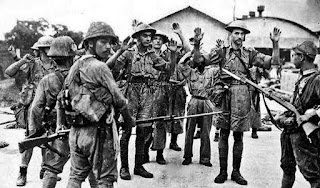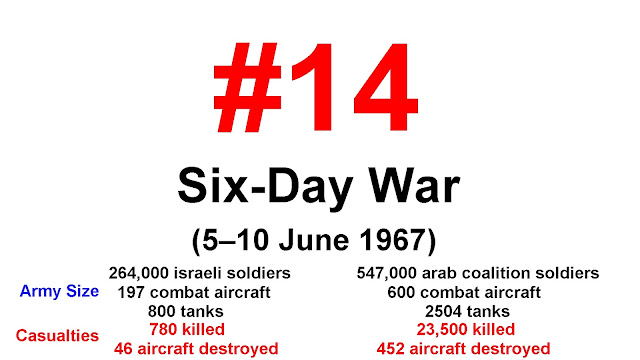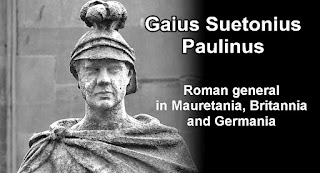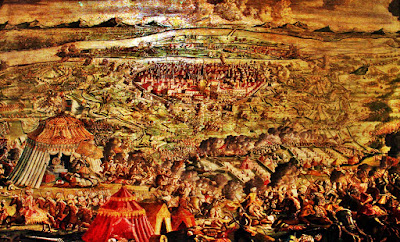20. The Battle of Gaugamela in 331 BC
The Battle of Gaugamela was the decisive battle of Alexander the Great's invasion of the Persian Achaemenid Empire. In 331 BC
Alexander's army of the Hellenic League met the Persian army of Darius III near Gaugamela, close to the modern city of Dohuk in Iraqi Kurdistan. Even though heavily outnumbered, Alexander emerged victorious due to his army's superior tactics and his deft employment of light infantry. It was a decisive victory for the Hellenic League and led to the fall of the Achaemenid Empire.
19. The Battle of Guandu in 200 AD
The Battle of Guandu was fought between the warlords Cao Cao
and Yuan Shao in 200 AD in the late Eastern Han dynasty. The battle, which concluded with a decisive victory for Cao Cao, was a turning point in the war between the two warlords. It marked the beginning of Cao Cao's gradual reunification of northern China, which made possible the establishment of the state of Cao Wei in the Three Kingdoms period.
18. The fall of Singapore in February 1942
The Battle of Singapore, also known as the Fall of Singapore, was
fought in the South-East Asian theatre of The Second World War when the Empire of Japan invaded the British stronghold of Singapore, nicknamed the "Gibraltar of the East". Singapore was the major British military base in South-East Asia and was the keystone of British imperial interwar defence planning for South-East Asia as well as the South-West Pacific. The fighting in Singapore lasted from 8 to 15 February 1942 although this was preceded by two months of British resistance as Japanese forces advanced down the Malaya peninsula.
It resulted in the Japanese capture of Singapore and the largest surrender of British-led military personnel in history. About 80000 British, Indian and Australian troops became prisoners of war, joining 50000 taken by the Japanese in the earlier Malayan Campaign. The British prime minister, Winston Churchill, called it the "worst disaster" in British military history.
17. The Battle of Kalka River, 1223
The Battle of the Kalka River, was fought between the MongolEmpire, whose armies were led by Jebe and Subutai the Valiant, and a coalition of several Rus' principalities, including Kiev and Galich, and the Cumans. They were under the joint command of Mstislav the Bold and Mstislav III of Kiev. The battle was fought on May 31, 1223 on the banks of the Kalka River in present-day Donetsk Oblast, Ukraine, and ended in a Mongol victory.
The Mongol army obliterates the allied Kievan-Rus'/Cuman army at a river crossing. The Mongols draw the Russo-Cuman force out until they are overextended, then attack with their heavy cavalry and destroy the allied forces in detail. The Mongols capture several Russian princes and ritually execute them by crushing them beneath a feasting table on which the Mongol leaders dance and feast.
16. The Battle of Narva in November 1700
The Battle of Narva on 30 November 1700, was an early battle inthe Great Northern War. A Swedish relief army under Charles XII of Sweden defeated a Russian siege force three to four times its size led by Charles Eugène de Croÿ. A blizzard against the Russian side allowed the Swedish army to win. Narva was not followed by further advances of the Swedish army into Russia. Tsar Peter the Great of Russia took Narva in a second battle in 1704.
15. The Siege of Alesia in 52 BC
The Battle of Alesia or Siege of Alesia was a military engagement inthe Gallic Wars that took place in September, 52 BC, around the Gallic fortified settlement of Alesia, a major centre of the Mandubii tribe. Gaius Julius Caesar, leading roughly 50000 Roman soldiers, laid siege to a
rebel Gaul army consisting of roughly 85000 infantrymen and 15000 cavalry led under Vercingetorix in the fortress of Alesia. The Belgae tribe attempted to relieve the siege with an army of 260000 warriors. The Romans, through the personal leadership of Titus Labienus, wrought a terrific slaughter upon the Belgae. This demoralising event led the defenders at Alesia to yield, ending Vercingetorix's rebellion.
14. The Six-Day War in 1967
The Six-Day War was fought between June 5 and 10, 1967 by Israeland the neighboring states of Egypt, Jordan, Syria, Irak and Lebanon. In reaction to the mobilisation of Egyptian forces along the Israeli border in the Sinai Peninsula, Israel launched a series of preemptive airstrikes against Egyptian airfields. Simultaneously, the Israelis launched a ground offensive into the Gaza Strip and the Sinai, which again caught the Egyptians by surprise.
Egyptian leader Gamal Abdel Nasser induced Syria and Jordan to begin attacks on Israel by using the initially confused situation to claim that Egypt had defeated the Israeli air strike. Israeli counterattacks resulted in the seizure of East Jerusalem as well as the West Bank from the Jordanians, while Israel's retaliation against Syria resulted in its occupation of the Golan Heights.
Arab casualties were far heavier than those of Israel. Israeli morale and international prestige was greatly increased by the outcome of the war and the area under Israeli control tripled.
13. The Battle of Julu in 207 BC
The Battle of Julu was fought in Julu, in present-day Xingtai, Hebei, China in 207 BC primarily between forces of the Qin dynasty and the insurgent state of Chu. The Qin commander was Zhang Han, while the Chu leader was Xiang Yu. The battle concluded with a decisive victory for the rebels over the larger Qin army. The battle marked the decline of Qin military power as the bulk of Qin's armies was destroyed in this battle.12. The Battle of Carrhae in 53 BC
The Battle of Carrhae was fought in 53 BC between the Roman Republic and the Parthian Empire near the town of Carrhae, a smalltown in modern-day Turkey. The Parthian General Surena decisively defeated a numerically superior Roman invasion force under the command of Marcus Licinius Crassus. Crassus, a member of the First
Triumvirate and the wealthiest man in Rome, had been enticed by the prospect of military glory and riches and decided to invade Parthia without the official consent of the Senate. Crassus marched his army directly through the deserts of Mesopotamia. His army clashed with Surena's force near Carrhae. Despite being heavily outnumbered, Surena's cavalry completely outmaneuvered the Roman heavy infantry, killing or capturing most of the Roman soldiers. Crassus himself was killed when truce negotiations turned violent.
It is commonly seen as one of the earliest and most important battles between the Roman and Parthian empires and one of the most crushing defeats in Roman history.
11. The Battle of Watling Street in 60 or 61 AD
The Battle of Watling Street took place in Roman-occupied Britainin AD 60 or 61 between an alliance of indigenous British peoples led by Boudica and a Roman army led by Gaius Suetonius Paulinus. Although heavily outnumbered, the Romans decisively defeated the
allied tribes, inflicting heavy losses on them. There was a rumour of 80000 Britons left dead on the battlefield, while around 400 Romans were dead according to Tacitus. The battle marked the end of resistance to Roman rule in Britain in the southern half of the island, a period that lasted until 410 AD.
10. The Battle of Karnal in 1739
The Battle of Karnal, February 24, 1739, was a decisive victory forNader, the Shāh of Iran, during his invasion of Mughal India. Nader's forces defeated the army of Muhammad Shah within three hours, despite being heavily outnumbered six-to-one, paving the way for the Persian sack of Delhi. The engagement is considered the crowning jewel in Nader's military career as well as a tactical masterpiece. The battle took place near Karnal, 110 kilometres north of Delhi, India.
9. The First battle of Panipat in 1526
The First Battle of Panipat, on 21 April 1526, was fought between the invading forces of Babur and the Lodi Empire. It took place in north India and marked the beginning of the Mughal Empire. This was one of the earliest battles involving gunpowder firearms and field artillery in India. Babur's guns proved decisive in battle, firstly because Ibrahim Lodi lacked any field artillery, but also because the sound of the cannon frightened Lodi's elephants, causing them to trample Lodi's own men.8. The Siege of Vienna in 1529
The Siege of Vienna in 1529 was the first attempt by the Ottoman Empire, led by Suleiman the Magnificent, to capture the city of Vienna, Austria. During the long journey from Bulgaria to Vienna, many Turkish large-calibre cannons and artillery pieces became hopelessly mired or bogged down, leaving Suleimanno choice but to abandon them, while camels brought from the empire's Eastern provinces, unused to the difficult conditions, were lost in large numbers. Sickness and poor health became common among the janissaries, claiming many lives along the perilous journey. Epic defence and bad weather conditions prevented the city from enemy conquest. The siege signalled the pinnacle of the Ottoman Empire's power and the maximum extent of Ottoman expansion in central Europe.
7. The Battle of Cartagena de Indias in March–May 1741
The Battle of Cartagena de Indias was an amphibious military
engagement between the forces of Britain under Vice-Admiral Edward Vernon and those of Spain under Admiral Blas de Lezo. It took place at the city of Cartagena de Indias in March 1741, in present-day Colombia. The battle was a significant episode of the War of Jenkins' Ear and a large-scale naval campaign. This battle, saw a huge British amphibious force of 26400 men and 186 ships beat back and defeated by 4000 Spanish troops and just 6 ships. The British pulled back after losing over 8000 men killed, 7500 wounded losing 1500 guns and 50 ships.
6. The Battle of Fei River in 383 AD
The Battle of Fei River in 383, where Fu Jiān of the Former Qin
Empire was decisively defeated by the numerically inferior army of
Eastern Jin. The location of the battle, the Fei River, no longer exists, but is believed to have flowed through modern Lu'an, Anhui, near the Huai River. The battle is considered to be one of the most significant battles in the history of China. The aftermath of the battle includes the Former Qin empire falling into massive civil war and its eventual destruction, ensuring the survival of Eastern Jin and other Chinese regimes south of the Yangtze River5. The Great Siege of Malta in 1565
The Great Siege of Malta took place in 1565 when the Ottoman Empire tried to invade the island of Malta, then held by the KnightsHospitaller. The Knights, with approximately 2000 footsoldiers and 400 Maltese men, women and children, withstood the siege and repelled the invaders. This victory became one of the most celebrated events in sixteenth-century Europe, and it undoubtedly contributed to the eventual erosion of the European perception of Ottoman invincibility and marked a new phase in Spanish domination of the Mediterranean.
4. The Battle of Tumu in 1449
Battle of Tumu was a frontier conflict between the Mongols and the Chinese Ming dynasty which led to the capture of the Zhengtong Emperor on September 1, 1449, and the defeat of an army of 500000 men by a much smaller force. This battle is regarded as the greatest military debacle of the entire Chinese history. There is a legend that Zhengtong Emperor had been working as a herder during the capture by Mongols.3. The Battle of Myeongnyang on October 26, 1597
Battle of Myeongryang in October 26, 1597, was fought between the Korean Joseon kingdom's navy, led by Admiral Yi Sun-sin, and the Japanese navy in the Myeongnyang Strait, near Jindo Island, off the southwest corner of the Korean peninsula. With 13 ships remaining from Admiral Won Gyun's disastrous defeat at the Battle of Chilchonryang, Admiral Yi held the strait as a "Last Stand" battle against a fleet of 133 Japanese warships and at least 200 logistical support ships.2. The Battle of Blood River on 16 December 1838
The Battle of Blood River is the name given for the battle fought between 470 Pioneers, led by Andries Pretorius, and an estimated 15000–21000 Zulu attackers on the bank of the Ncome River on 16 December 1838, in what is today KwaZulu-Natal, South Africa. Casualties amounted to 3000 of king Dingane's soldiers dead, including two Zulu princes competing with prince Mpande for the Zulu throne. Three Pioneers commando members were lightly wounded, including Pretorius himself.
1. The Battle of Cochin in 1504
The Battle of Cochin, sometimes referred as the Second Siege of Cochin, was a series of confrontations, between March and July 1504, fought on land and sea, principally between the Portuguese garrison at Cochin, allied to the Trimumpara Raja, and the armies of the Zamorin of Calicut and vassal Malabari states.The celebrated heroics of the tiny Portuguese garrison, led by Duarte Pacheco Pereira, fended off an invading army several hundred times bigger. It proved a humiliating defeat for the Zamorin of Calicut. He not only failed to conquer Cochin, but his inability to crush the tiny opposition undermined the faith of his vassals and allies. The Zamorin lost much of his traditional authority over the Malabar states of India in the aftermath. The preservation of Cochin secured the continued presence of the Portuguese in India.















































